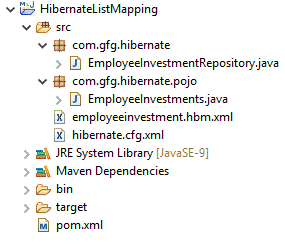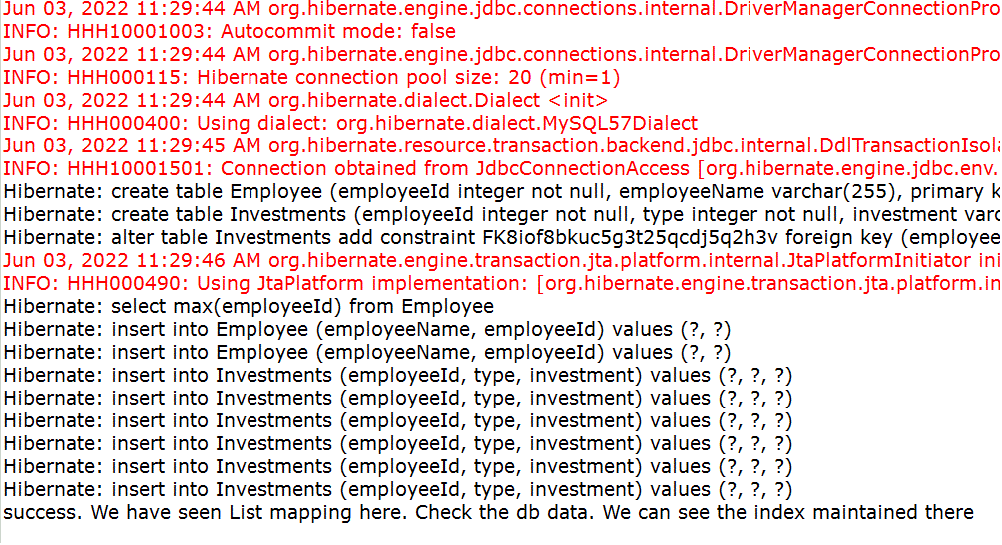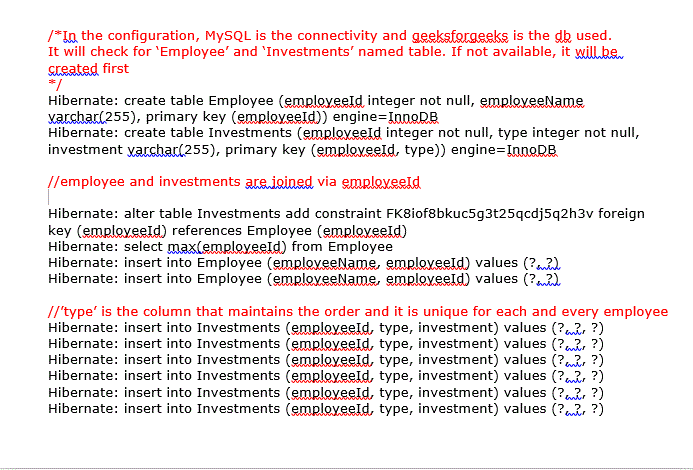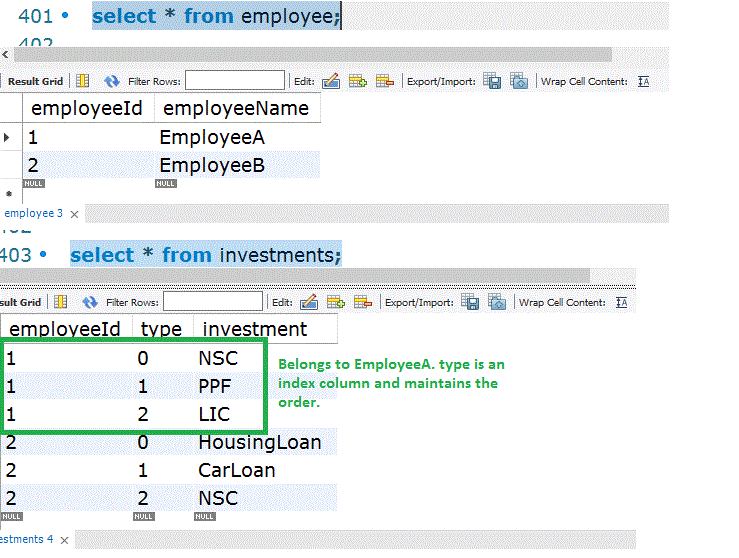Hibernate Mapping List (original) (raw)
Last Updated : 10 Jun, 2022
In Hibernate, in order to go for an ordered collection of items, mostly List is the preferred one, Along with List, we have different collection mapping like Bag, Set, Map, SortedSet, SortedMap, etc., But still in many places mapping list is the most preferred way as it has the index element and hence searching wise, doing any CRUD operation wise it is easier. We can see this here via employees and their saving plans. One employee can do multiple investments. we can see that here.
Example Project
Project Structure:

This is a maven-driven project.
pom.xml
XML `
4.0.0 HibernateListMapping HibernateListMapping 0.0.1-SNAPSHOT src src **/*.java maven-compiler-plugin 3.8.1 9 org.hibernate hibernate-core 5.4.15.Final mysql mysql-connector-java 5.1.34 <maven.compiler.source>1.8</maven.compiler.source> <maven.compiler.target>1.8</maven.compiler.target>
`
Let us see the main configuration files
employeeinvestment.hbm.xml
XML `
`
hibernate.cfg.xml
XML `
<session-factory>
<!-- As we are connecting mysql, those driver classes,
database name, username and password are specified
Please change the information as per your requirement -->
<property name="hbm2ddl.auto">update</property>
<property name="connection.driver_class">com.mysql.jdbc.Driver</property>
<property name="connection.url">jdbc:mysql://localhost:3306/geeksforgeeks?serverTimezone=UTC</property>
<property name="connection.username">root</property>
<property name="connection.password">admin</property>
<property name="show_sql">true</property>
<mapping resource="employeeinvestment.hbm.xml" />
</session-factory>`
Let us see the POJO class now
EmployeeInvestments.java
Java `
import java.util.List; public class EmployeeInvestments {
// data member for employee
private int employeeId;
private String employeeName;
// investments
private List<String> investments;
public int getEmployeeId() { return employeeId; }
public void setEmployeeId(int employeeId)
{
this.employeeId = employeeId;
}
public String getEmployeeName() { return employeeName; }
public void setEmployeeName(String employeeName)
{
this.employeeName = employeeName;
}
public List<String> getInvestments()
{
return investments;
}
public void setInvestments(List<String> investments)
{
this.investments = investments;
}}
`
Java file for adding and listing the data
EmployeeInvestmentRepository.java
Java `
import com.gfg.hibernate.pojo.EmployeeInvestments; import java.util.ArrayList; import org.hibernate.Session; import org.hibernate.SessionFactory; import org.hibernate.Transaction; import org.hibernate.boot.Metadata; import org.hibernate.boot.MetadataSources; import org.hibernate.boot.registry.StandardServiceRegistry; import org.hibernate.boot.registry.StandardServiceRegistryBuilder;
public class EmployeeInvestmentRepository { public static void main(String[] args) { StandardServiceRegistry standardServiceRegistry = new StandardServiceRegistryBuilder() .configure("hibernate.cfg.xml") .build(); Metadata meta = new MetadataSources(standardServiceRegistry) .getMetadataBuilder() .build();
SessionFactory sessionFactory
= meta.buildSessionFactory();
Session session = sessionFactory.openSession();
Transaction transaction
= session.beginTransaction();
ArrayList<String> investmentList1
= new ArrayList<String>();
investmentList1.add("NSC");
investmentList1.add("PPF");
investmentList1.add("LIC");
ArrayList<String> investmentList2
= new ArrayList<String>();
investmentList2.add("HousingLoan");
investmentList2.add("CarLoan");
investmentList2.add("NSC");
EmployeeInvestments employeeInvestment1
= new EmployeeInvestments();
employeeInvestment1.setEmployeeName("EmployeeA");
employeeInvestment1.setInvestments(investmentList1);
EmployeeInvestments employeeInvestment2
= new EmployeeInvestments();
employeeInvestment2.setEmployeeName("EmployeeB");
employeeInvestment2.setInvestments(investmentList2);
session.persist(employeeInvestment1);
session.persist(employeeInvestment2);
transaction.commit();
session.close();
System.out.println(
"success. We have seen List mapping here. Check the db data. We can see the index maintained there");
}}
`
On running the project, we can see the output below.
Output:

Let us see the query that got executed

Let us check MySQL DB data

Conclusion
In the above, we have seen how to use the mapping list in the hibernate. Wherever ordering is necessary, we can go for List mapping.